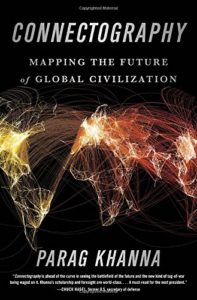We have long been defining territories based on political, cultural, and sometimes based on geological boundaries. But the world has changed since Ptolemy charted one of the first maps to mark locations. These political boundaries have, if anything, divided the human race and created barriers to free flow of ideas, material, and money. But there are new factors shaping our world. In Connectography, Parag Khanna explores these new forces that are restructuring our world as we invest trillions of dollars to connect people from the remote corners of Earth.
Parag Khanna is a global strategist, world traveler, and bestselling author. He is a CNN Global Contributor and a Senior Research Fellow at the Lee Kuan Yew School of Public Policy at the National University of Singapore.
He has been a fellow at the New America Foundation and Brookings Institution, advised the U.S. National Intelligence Council, and worked in Iraq and Afghanistan as a senior geopolitical adviser to U.S. Special Operations Forces. He holds undergraduate and graduate degrees from the School of Foreign Service at Georgetown University and a Ph.D. from the London School of Economics.
 Connectography: Mapping the Future of Global Civilization
Connectography: Mapping the Future of Global Civilization
Hardcover: 496 pages
Publisher: Random House (April 19, 2016)
Language: English
ISBN-10: 0812988558
ISBN-13: 978-0812988550
The author points out how landmass and and military might alone once ensured prosperity of a country. With increasing trade and globalization, this territorial supremacy is no longer the only factor. In our new connected world, who and how you are connected to the world is more important than the amount of land you control. His emphasis is on a new way of looking at the world map. One which shows the flow of material, resources, and ideas over political boundaries.
He says, Globalization is entering a new golden age. Where millions of people and businesses can now reach others across the globe at a fraction of the cost, because of improved infrastructure and technology. A skilled entrepreneur sitting in a remote rural town can offer soft services to people in booming metros with almost zero delay. Although the US and western countries still lead in trade, the new globalization has made them much more dependent on global trade. With increasing connectivity, we are seeing more players enter the supply chain. What was once manufactured in China, is now shifting to poorer Africa. To stay ahead, the author says, America will have to take the lead in connecting with more countries and find new trade partners. Invest in emerging manufacturing hubs and allow investment on its soil, to counter China’s multi-pronged trade surge.
If wars and colonization and mega-nations was the theme of pre-colonial era, the post World War II time has seen a steady increase in decentralization and formation of new countries, and new states within countries. The author sees this devolution as the process of aggregation. He shows how this disintegration is leading to new associations and new maps. But instead of political and territorial, these maps are functional associations that are shaping new economic powerhouses from ASEAN in the east to African unions and the South American trade blocs.
In Connectogrpahy, Parag Khanna gives you the history of how countries and economies were built, how they scaled and how they fell. He looks at the political developments, but he also looks at how technology and the changing geopolitical forces have affected trade. How global trade and flow of money are restructuring the world that we live in. With various examples of countries, cities, and trade associations, he shows how the most connected and nimble administrations will rise in the new world. Connectography is a treasure trove of information and insights if you want to examine how trade and connections are poised to affect financial health and write new destinies.